#at the time I had no idea that oak trees were the most spiritually significant type of tree in pagan faiths the world over
Text

#light being#images that break computers#magic#is real#the light being later chose to grace a random disposable film camera pic my fren took of me on a hike#lesson perhaps being#that we can ask the Universe and receive it#but we receive it on the universe's terms not our own#but know that you will receive what you ask God for#find me a disposable camera flare that looks like this please#I've never seen a camera flare do this#camera flares come out as perfect circles yet this thing is clearly on a ballistic trajectory showering me in golden light#it looks just like the light being I saw but blurred by its crazy fast motion#mind you this thing could not teleport#But it was so much faster than anything I've ever seen in my 3 1/2 decades of life I've seen quite a bit#ufo of tumblr#does it count as a UFO it's tiny?#why not?#also fact that I saw it in an oak tree tell me a faer amount#at the time I had no idea that oak trees were the most spiritually significant type of tree in pagan faiths the world over#but as I've told this account to more and more people I've learned that to be historically true#so we can log this as another reason why Oak trees are considered so sacred#The fairies really seem to like oak trees#fuggit I really like oak trees too#if it make me a prophet that I've seen a fairy I'm cool with that#heavenly energy feels at home around me#get used to it#I stay as woke and enlightened as possible and I'm always down to learn more#lifetime student and lifetime teacher#When I don't know I say I don't know I'm comfortable with that too
2 notes
·
View notes
Text
Historical Holiday Traditions We Really Need To Bring Back
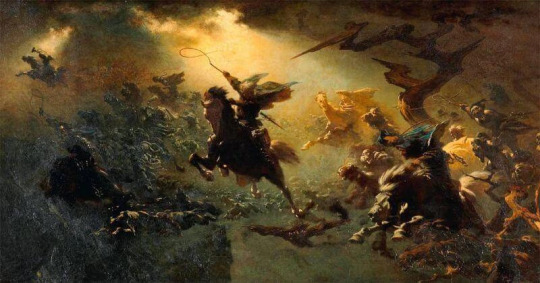
Here comes Santa Claus, and also a bunch of annual holiday Things we do to ensure he commits a truly boggling act of breaking and entering and leaves goods underneath the large plant in the living room.
Because I’ve always got a hankerin’ for the days of yore, here are some historical holiday traditions we really need to bring back:
1. Everything that happened on Saturnalia
Saturnalia was the ancient Roman winter festival held on December 25th--which is why we celebrate Christmas on that day and not on the day historians speculate Jesus was actually born, which was probably in the spring.
Saturnalia was bonkers. As the name suggests, it celebrated the god Saturn, who represented wealth and liberty and generally having a great time.
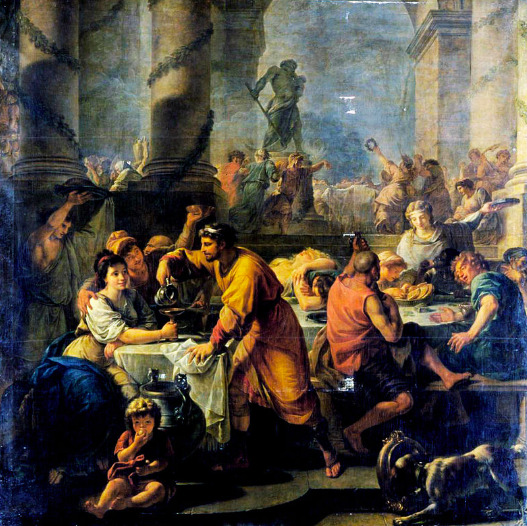
Above: Their party is way cooler than yours could ever hope to be.
During Saturnalia, masters would serve their slaves, because it was the one day during the year when everybody agreed that freedom for all is great, actually, let’s just do that. Everyone wore a coned hat called the pilleus to denote that they were all bros and equal, and also to disguise the fact that they hadn’t brushed their hair after partying hard all week, probably.
Gambling was allowed on Saturnalia, so all of Rome basically turned into ancient Vegas, complete with Caesar’s Palace, except with the actual Caesar and his palace because he was, you know. Alive.
The most famous part (besides getting drunk off your rocker) was gift-giving--usually gag gifts. Historians have records of people giving each other some truly impressive white elephant gifts for Saturnalia, including: a parrot, balls, toothpicks, a pig, one single sausage, spoons, and deliberately awful books of poetry.
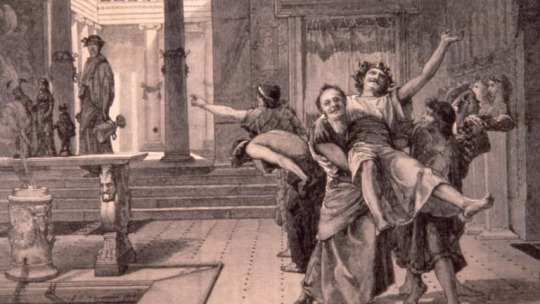
Above: Me, except all the time.
Partygoers also crowned a King of Saturnalia, which was a predecessor to the King of Fools popular in medieval festivals. The king was basically the head idiot who delivered absurd commands to everyone there, like, “Sing naked!” or “run around screaming for an hour,” or “slap your butt cheeks real hard in front of your crush; DO IT, Brutus.”
Oh, wait. Everyone was already doing all that. Hell yes.
(Quick clarification: early celebrations of Saturnalia did feature human sacrifice, so let’s just leave that bit out and instead wear the pointy hats and sing naked, okay? Io Saturnalia, everybody.)
2. Leaving out treats for Sleipnir in the hopes of avoiding Odin’s complete disregard for your property
The whole “leave out cookies and milk for Santa” thing comes from a much older tradition of trying to appease old guys with white beards. In Norse mythology, Odin, who was sort of the head god but preferred to be on a perpetual road trip instead, took an annual nighttime ride through the winter sky called the Wild Hunt.
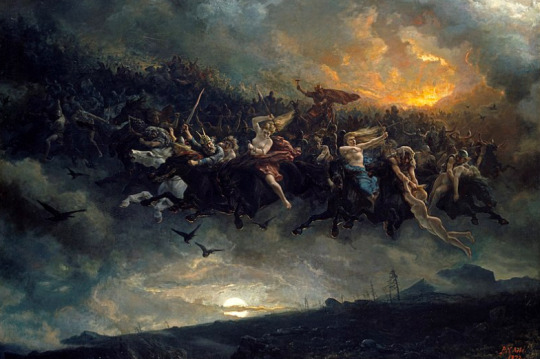
Above: The holidays, now with 300% more heavy metal.
Variations of the Wild Hunt story exist in a bunch of European folklore--in Odin’s case, he usually brought along a bunch of supernatural buddies, like spirits and other gods and Valkyries and ghost dogs, who, the Vikings said, you could hear howling and barking as the group approached (GOOD DOGGOS).
That was the thing, though; you never actually saw Odin’s hunt--you only heard it. And hearing it did not spark the same sense of childish glee you felt when you thought you heard Santa’s sleigh bells approaching as a kid--instead, the Vikings said, you should be afraid. Be VERY afraid.
Because Odin could be kind of a dick.
Odin was also known as the Allfather, and like any father, he hated asking for directions. GPS who? I’m the Allfather, I’m riding the same way I always ride.
And that was pretty much it: “I took this road last year and I’m taking it again this year.”
“But,” someone would pipe up from the back, “there are houses on the road now--we’re gonna run right into them. We could just take a different path; there’s actually a detour off the--”
“Nope,” Odin would say. “They know the rules. My road, my hunt, my rules. We’re going this way.”
So if you were unlucky enough to have built your house along one of Odin’s favorite road trip sky-ways, he wouldn’t just plow right past you.
He would burn your entire house down--and your family along with it.
Kids playing in the yard? Torch ‘em; they should have known better. Grandma knitting while she waits for her gingerbread Einherjar to finish baking? Sucks to be her; my road, my rules, my beard, I’m the Allfather, bitch.
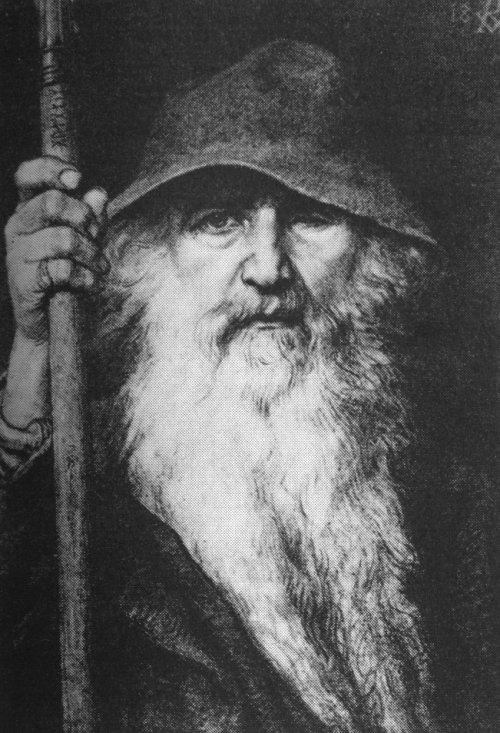
Above: Santa, but so much worse.
To be fair to Odin, he could be a cool guy sometimes. He just turned into any dad when he was on a road trip and wanted to MAKE GOOD TIME, DAMN IT, I AM NOT STOPPING; YOU SHOULD HAVE PEED BEFORE WE LEFT.
To ensure they didn’t incur Odin’s road trip wrath, the Vikings had a few ways of smoothing things over with Dad.
They would leave Odin offerings on the road, like pieces of steel (??? okay ???) or bread for his dogs, or food for his giant, eight-legged horse, Sleipnir, because the only true way to a man’s heart is through his pet.
People would generally leave veggies and oats and other horse-y things out for Sleipnir, whose eight legs made him the fastest flying horse in the world and also made him the only horse to ever win Asgard’s coveted tap dancing championship.
(Side note: EIGHT legs...EIGHT tiny reindeer...eh? Eh? See how we got here? Thanks, nightmare horse!)

Above: An excellent prancer AND dancer.
And if Odin was feeling particularly charitable and not in the mood for horrific acts of arson, children would also leave their shoes out for him--it was said that he’d put gifts in your boots to ring in a happy new year.
If all that didn’t work and the Vikings heard the hunt approaching, they would resort to throwing themselves on the ground and covering their heads while the massive party sped above them like a giant Halloween rager.
So this holiday season, leave your boots out for Odin and some carrots out for his giant spider horse or you and your entire family will die in a fiery inferno, the end.
3. Yule Logs
Speaking of Scandinavia, another Northern European winter solstice tradition was the yule log. Today, if you google “yule log,” something like this will pop up:
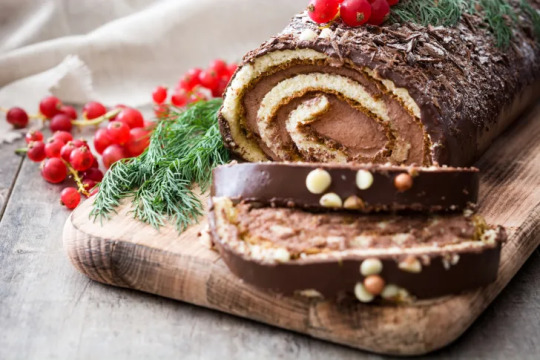
...which isn’t an actual log, but is instead log-shaped food that you shove into your mouth along with 500 other cakes at the same time because it’s CHRISTMAS, and I’m having ME TIME; so WHAT if I ate the whole jar of Nutella by myself, alone, in the dark at 3 am?
But that log cake is actually inspired by actual logs of yore that Celtic, Germanic, and Scandinavian peoples decorated with fragrant plants like holly, ivy, pinecones, and other Stuff That Smells Nice before tossing the log into the fire.
This served a few purposes:
It smelled nice, and Bath and Body Works scented candles hadn’t been invented yet.
It had religious and/or spiritual significance as a way to mark the winter solstice.
It was a symbolic way of ringing in the new year and kicking out the old.
Common belief held that the ashes of a yule log could ward off lightning strikes and bad energy.
Winter cold. Fire warm.
Everybody loves to watch things burn. (See: Odin.)
The yule log cakes we eat today got their start in 19th century Paris, when bakers thought it was a cute idea to resurrect an ancient pagan tradition in the form of a delicious dessert, and boy, howdy, were they right.
In any case, I’m 100% down with eating a chocolate yule log while burning an actual yule log in my backyard because everybody loves to watch things burn; winter cold, fire warm; and hnnnngggg pine tree smell hnnnnggg.
(Quick note: The word “yule” is the name of a traditional pagan winter festival, still celebrated culturally or religiously in modern pagan practice. It’s also another name for Odin. He had a bunch of other names, one of the most well-known being jólfaðr, which is Old Norse for “Yule father.” If you would like to royally piss him off, or if you are Loki, feel free to call him “Yule Daddy.”)
4. Upside down Christmas trees
I just found out that apparently, upside down Christmas trees are a hot new trend with HGTV types this year, so I guess this is one historical trend we did bring back, meaning it doesn’t really belong on this list, but I’m gonna talk about it, anyway.

Side note: Oh, my god, that BANNISTER. I NEED.
Historians aren’t actually sure where the inverted Christmas tree thing came from, but we know people were bringing home trees and then hanging them upside down in the living room as early as the 7th century. We have a couple theories as to why people turned trees on their heads:
Logistically, it’s way easier to hang a giant pine tree from your rafters upside down by its trunk and roots. You just hoist that baby up there, wind some rope around the rafter and the trunk, and boom. Start decorating.
A Christian tradition says that one day in the 7th century, a Benedictine monk named Saint Boniface stumbled across a group of pagans worshipping an oak tree. So, instead of minding his own damn business, he cut the tree down and replaced it with a fir tree. While the pagans were like, “Dude, what the hell?” Boniface used the triangular shape of the fir tree to explain the concept of the holy trinity to the pagans. Some versions have him planting it right-side up, others having him displaying a fir tree upside down. Either way, it’s still a triangle that’s a solid but ultimately very rude way of explaining God. Word’s still out on whether anyone was converted or just rightly pissed off that this random guy strolled into their place of worship, chopped down their sacred tree, and plopped HIS tree down instead. Please do not do that this holiday season.
Eastern Europeans lay claim to the upside-down tree phenomenon with a tradition called podłazniczek in Poland--people hung the tree from the ceiling and decorated it with fruits and nuts and seeds and ribbons and other festive doodads.

(God, who lives in these houses? Look at that. That’s like a swanky version of Gaston’s hunting lodge. Where do I get one? Which enchanted castle do I have to stumble into to chill out in a Christmas living room like that?)
Today, at least in the West, upside-down trees are making a comeback because...I don’t know. Chip and Joanna Gaines said so.
Some folks say it’s a surefire way to keep your cats from clawing their way through the tree and then puking up fir needles for weeks afterward, which checks out for me.
5. Incredibly weird Victorian Christmas cards
So back in the 19th century, the Christmas card industry was really getting fired up. Victorians loved their mail, let me tell you. They loved sending it. They loved getting it. They loved writing it. They loved opening it. They loved those sexy wax seals you use to keep all that sweet, sweet mail inside that sizzling envelope. (Those things are incredibly sexy. Have you ever made a wax seal? Oh, man, it’s hot.)
The problem, though, was that while the Victorians arguably helped standardize many of the holiday traditions we know and love today (Christmas trees, caroling, Dickens everything, spending too much money, etc.) back in 1800-whenever, a lot of that Christmas symbolism was, um...still under construction. No one had really agreed on which visual holiday cues worked and which...didn’t.
Meaning everyone just kind of made up their own holiday symbols. Which resulted in monstrous aberrations like this card:

What the hell is that? A beet? Is that a beet? Or a turnip? Why is it...oh, God, why does it have a man’s head? Why does the man beet have insect claws?
What is it that he’s holding? A cookie? Cardboard? A terra cotta planter?
And then there’s this one:
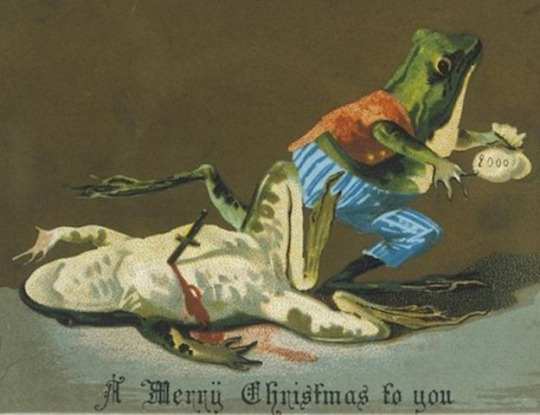
“A Merry Christmas to you,” it says, while depicting a brutal frog murder/mugging.
What are you trying to tell me? Are you threatening me with this card? Is that it? Is this a threat? How the hell am I supposed to interpret this? “Merry Christmas, hide your money or you’re dead, you stupid bitch.”
Also, why is the dead frog naked? Did the other frog steal his clothes after the murder? WHAT AM I SUPPOSED TO DO WITH THIS?
Victorian holiday cards also doubled as early absurdist Internet memes, apparently, because how else do I explain this?

Is this some sort of tiny animal Santa? A mouse riding a lobster? Like, the mouse, I get. Mice are fine. Disney built an empire on a mouse. And look, he’s got a little list of things he’s presumably going to bring you: Peace, joy, health, happiness. (In French. Oh, wait, is that that Patton Oswalt rat?)
But a LOBSTER? What’s with the lobster? It’s basically a sea scorpion. Why in the name of all that is good and holy would you saddle up a LOBSTER? I hate it. I hate it so, so much. Just scurrying around the floor with more legs than are strictly necessary, smelling like the seafood section of Smith’s, snapping its giant claws.
This whole card is a health inspector’s worst nightmare. It really is.
I gotta say, though, I am a fan of this one:

Presumably, that polar bear is going in for a hug because nothing stamps out a polar bear’s innate desire to rip your face from your skull than candy canes and Coke and Christmas spirit.
This next one is actually fantastic, but for all the wrong reasons:
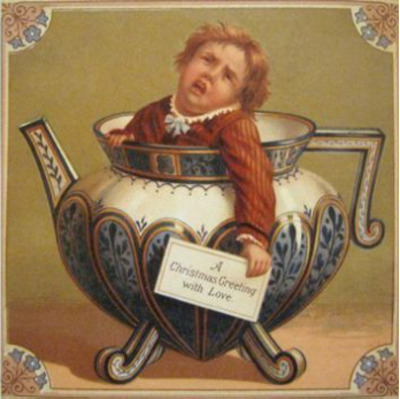
I know everyone overuses “same” these days but geez, LOOK at that kid. I can HEAR it. SAME.
If you’ve ever been in a shopping mall stuffed with kids, nothing sums it up better than this card. This is like the perverse version of those Anne Geddes portraits that were everywhere in the late 90s. “Make wee Jacob sit in the tea pot; everyone will--Jacob, STOP, look at Mommy; I said LOOK. AT. MOMMY--everyone will love it.”
Actually, you know what? Every other Christmas card is cancelled. This is the only card we will be using from now on. This is it.
Wait, no. We can also use this one:
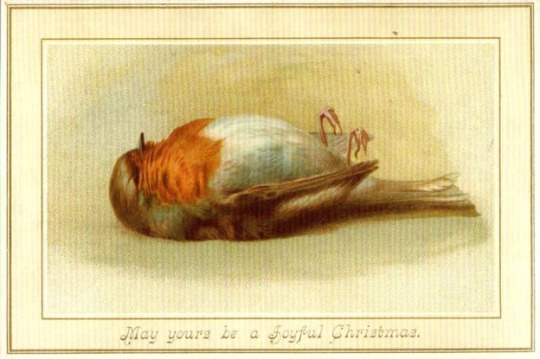
Merry Christmas. Here’s a fuckin’...just a dead fuckin’ bird.
2K notes
·
View notes
Text
Single trees are extraordinary; trees in number more remarkable still. To walk in a wood is to find fault with Socrates’s declaration that ‘Trees and open country cannot teach me anything, whereas men in town do.’ Time is kept and curated and in different ways by trees, and so it is experienced in different ways when one is among them. This discretion of trees, and their patience, are both affecting. It is beyond our capacity to comprehend that the American hardwood forest waited seventy million years for people to come and live in it, though the effort of comprehension is itself worthwhile. It is valuable and disturbing to know that grand oak trees can take three hundred years to grow, three hundred years to live, and three hundred years to die. Such knowledge, thoughtfully considered, changes the grain of the mind.
- Robert Macfarlane, The Old Ways: A Journey on Foot
Recently we drove to Couer d’Alene. North of town, I saw a strikingly handsome building set in a grove of old-growth trees. It was not a natural landscape, but when the building was constructed, the developer had left some ancient Douglas fir and ponderosa pine and created the impression of a long solidity in the landscape for his construction. It is rare for a builder to go to such trouble because it is simpler and more economical to clear a lot and build than to build around trees and other natural landscape elements. As we sat at the traffic light and I studied the property with its balance of trees, the stone and woodwork of the building, I wondered how the trees had experienced this construction and the loss of so many other trees in that particular stand.
Two years ago, I witnessed a tree apparently doing something that I suspect I was not meant to see. Marilyn had just placed a planter full of new young plants on a deck rail, which was under the canopy of a very ancient willow. Out of the corner of my eye, I caught movement and turned just in time to see the willow purposely lift a frond and stroke the young plants. The action was like an arm lifting and then stroking the plants, and the movement occurred twice, lifting and returning, lifting and returning like a parent might stroke the head of a much-loved child.
I have had the privilege of many odd and spiritual experiences – especially after I moved to New Mexico. Still, this particular moment in the pacific northwest haunts me as maybe the most significant spiritual moment of my life. I feel as though I saw a moment we are not privileged to see, and if we do see, it is under the influence of a mind-altering chemical like LSD, a moment when our ego is de-potentiated and no longer in control of our perceptions. I have had such experiences using LSD, but that was 50 years ago, and I doubt that I was having a flashback at this late date.
Humanity suffers incredible hubris. We speak of looking to space to find intelligent life when we are actually looking for life like us. I suspect if we ever do find life like us, it will be terrifying – it will be a life driven by insularism and an attitude that cannot see us as an equal and will more than likely only see us in terms of our utility or see us in terms of something in the way, much like we see trees, wolves and everything else on this planet.
We now scientifically know that trees and plants in forests have a massive communication network of mutually sustainable interactions.
“In the 1960s, CIA interrogation expert Cleve Backster experimented with polygraph machines when he stumbled onto something novel. He noticed what appeared to be a change in electrical resistance with one of the plants, to which he connected the polygraph equipment whenever he removed a leaf or even “threatened” to harm the plant by intent alone. He likened this sudden electrical pulse to a “scream” emitted by the plant in response to endangerment.
While Backster’s theory was considered a crackpot idea, many would follow similar, unusual observations about the behavior of plants, which seemingly represented a sort of “communication” they might be capable of.
For instance, a 1989 AP article discussed what one physicist, named Ed Wagner, believed were evidence he found of plant communication via what he called “W-waves”:
Physicist Ed Wagner says he has found evidence that trees talk to each other in a language he calls W-waves. “If you chop into a tree, you can see that adjacent trees put out an electrical pulse,” said Wagner. “This indicates that they communicated directly.”
Explaining the phenomenon, Wagner pointed to a blip on a strip chart recording of the electrical pulse. “It put out a tremendous cry of alarm,” he said. “The adjacent trees put out smaller ones…. People have known there was communication between trees for several years, but they’ve explained it by the chemicals trees produce,” Wagner said. “But I think the real communication is much quicker and more dramatic than that,” he said. “These trees know within a few seconds what is happening. This is an automatic response.”
Wagner has measured the speed of W-waves at about 3 feet per second through the air. “They travel much too slowly for electrical waves,” he said. “They seem to be an altogether different entity. That’s what makes them so intriguing. They don’t seem to be electromagnetic waves at all.”
Another physicist, William Corliss, also took an interest in Wagner’s discovery, noting that, “The voltage measured by electrodes implanted in trees goes up and down as one goes higher and higher up the trees… incidentally, electricity does seem to affect plant growth.”
In more recent years, the idea of plants capable of forms of “communication” has been considered a bit more thoughtfully and is not outright shunned by the scientific community. One leading modern researcher and advocate for the varieties of ways plants communicate is Suzanne Simard, whose work with plants has helped set new precedents for how interactions between various species of flora occur. Simard’s research began to coalesce around what became a doctoral thesis two decades ago, in which she argued that a variety of communication methods were used by trees to achieve everything from expressing their needs to sharing nutrients “via a network of latticed fungi buried in the soil.” She further studied the varieties of ways that fungal filigrees were exploited by trees in ways that allowed them to send signals to other plants nearby about changes in the environment and even “helping” endangered plants by transferring and sharing nutrients with them.
Speaking with “Yale Environment 360” last year, she talked about how, as she puts it, a forest “is a cooperative system,” saying:
“To me, using the language of ‘communication’ made more sense because we were looking at not just resource transfers, but things like defense signaling and kin recognition signaling. We as human beings can relate to this better. If we can relate to it, then we’re going to care about it more. If we care about it more, then we’re going to do a better job of stewarding our landscapes.”
Despite having communicative abilities, plants generally aren’t deemed to have any sort of intelligence. However, there are still some members of the scientific community that argue this is not necessarily the case. Author and researcher Michael Pollan, who studies the field of plant neurobiology, argues that plants are more perceptive than many would think:
“They have analogous structures… They have ways of taking all the sensory data they gather in their everyday lives … integrate it, and then behave appropriately in response. And they do this without brains, which, in a way, is what’s incredible about it because we automatically assume you need a brain to process information.”
Understanding how various life forms on earth communicate and cooperate with each other gives us a much broader sense of what “life on Earth” is truly about. It also challenges us to consider whether more complex interaction systems exist between organisms, including those that aren’t deemed intelligent or even responsive, by humans.
In the case of plants, it seems unusual that these organisms, while deemed
to be very much alive, have long been relegated to being unresponsive and “vegetative,” in the most literal sense. Maybe it’s indeed time we start paying closer attention to our floral kindred and the subtleties of their interactions with each other and their environment.” Trees That Talk: The Bizarre World of Plant Communication Micah HanksJuly 2, 2017
As I come closer to the ending of my own span of years on this earth, I have become more acutely aware of the commonality I have with all life. Fear and suffering appear to be the same across all species, and I am beginning to wonder if love is also – not romantic love, but the deep logos love spiritual people have written about for millennia.
I understand there are reasons we avoid seeing these connections and being aware of the “intelligence,” love, and fear of life around us.
The Danish/Inuit Arctic explorer Kund Rassmussen once wrote,
“The greatest peril of life lies in the fact that human food consists entirely of souls. All the creatures that we to kill and eat, all those that we have to strike down and destroy to make clothes for ourselves, have souls, souls that do not perish with the body and which must therefore be pacified lest they revenge themselves on us for taking away their bodies.”
That is seen as a very primitive view, yet I wonder in our confusion of scientific methods for technological growth and exploitation if we are the primitives and the barbarians.
I suspect our blindness to the intelligence of life here on earth, intelligence other than ourselves, is summed up in that statement.
Maybe all intelligence really is is the knowledge that everything is connected and what we call intelligence is a form of narcissistic blindness. Perhaps the natural intelligence is in the willow, lifting a frond to stroke young plants that came under his/her/its protection and scope. Maybe the only innate intelligence is displayed in how we honor, respect, and care for everything.
In addition to slowing me down in my interaction with the world, I find that this view brings me a sense of greater peace and a change in focus about what is and is not essential and how to express that “essentialness.”
I also have greater clarity about what the ancients meant when they wrote of a fear of God. It is not a fear full of the pain of punishment – it is an awe that is hard to express and is likely to bring tears and an awareness of the pity of things and our oneness with everything.
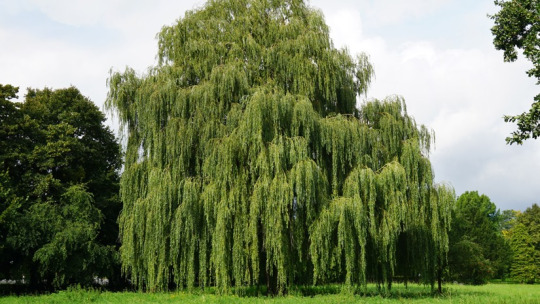
8 notes
·
View notes
Note
hello! im in south wales and have been trying to research how the people of wales (generally) worshipped cerridwen? i can't find much except from the welsh mythology so im wondering if there's a certain etiquette like there is in Hellenism?
Hi, thanks for your question.
As I am sure you know, while we have some of the myths, any cultus of the welsh people before Christianity is mostly lost. Although:
From what I know all Celts used Votive offerings to the gods similar to Hellenism, although it was more items rather than liquid or food (though that doesn’t mean you can’t offer these things) and there were certain places that were visited at certain times of the year to offer/sacrifice something to the gods as individuals and as a community.
Votive offerings (wikipedia)
The Celts made votive offerings to their deities, which were buried in the earth or thrown into rivers or bogs. According to Barry Cunliffe, in most cases, deposits were placed in the same places on numerous occasions, indicating continual usage "over a period of time, perhaps on a seasonal basis or when a particular event, past or pending, demanded a propitiatory response."[41]
In particular, there was a trend to offer items associated with warfare in watery areas, evidence for which is found not only in the Celtic regions, but also in Late Bronze Age (and therefore pre-Celtic) societies and those outside of the Celtic area, namely Denmark. One of the most notable examples is the river Thames in southern England, where a number of items had been deposited, only to be discovered by archaeologists millennia later. Some of these, like the Battersea Shield, Wandsworth Shield and the Waterloo Helmet, would have been prestige goods that would have been labour-intensive to make and thereby probably expensive.[41] Another example is at Llyn Cerrig Bach in Anglesey, Wales, where offerings, primarily those related to battle, were thrown into the lake from a rocky outcrop in the late first century BCE or early first century CE.[41]
At times, jewellery and other high prestige items that were not related to warfare were also deposited in a ritual context. At Niederzier in the Rhineland for example, a post that excavators believed had religious significance had a bowl buried next to it in which was contained forty-five coins, two torcs and an armlet, all of which made out of gold, and similar deposits have been uncovered elsewhere in Celtic Europe.[42]
As for Cerridwen, there is not a lot of info out there. Personally, I see her as a goddess of inspiration, a tenth muse if you will, (which does not diminish her power and strength) especially as when she created awen in her cauldron nine female figures were seen in the smoke. So you could look into how they were worshipped and reconnect it to welsh culture.
A book that does go into how she is worshipped and seen in modern times is:
Hughes, K. (2018) The Book of Celtic Magic: Transformative Teachings from the Cauldron of Awen. Llewellyn Publications: Minnesota U.S.
Kristoffer Hughes is a welsh druid and part of the Anglesey Druid grove, and explores the welsh god's spiritual functions in his book. Which looks into her function as a witch goddess.
"Cerridwen
Spiritual Function: lessons in inspiration and transformation, listening to the land and responding to it in a proactive manner. She is assertive, not passive, and this quality is reflected in her teachings.
Magical Ally Function: For acts of magic that require deep transformation, inspiration, and clarity. She is useful for all acts of magic as a teacher, assistant, and guide. She is particularly effective in helping with herb and plant lore."
"Cerridwen offers us the route to empowerment, magic, and transformation… She is the mother in the guise of magician - the great witch… she was muse to the bards of mediaeval Wales and continues to be regarded as the mother of Awen… she is versed in the acts of sorcery, conjuration, and divination… Cerridwen is the transformer; she is the source of magic and the great witch queen."
So considering all this, the etiquette would be for your sacrifices to be offered in more nature-based places. Such as local places connected to mythology, near oak trees due to her connection to the druids, on spiritual holidays - Halloween or Mayday.
Alternatively, you could always set up a shrine in your house or garden, where you could offer items of inspiration - hymns, songs, poems, journal entries, letters, artwork, or things that have inspired you. Grow plants (witchy herbs etc), help others find their path, help protect the land in her name.
You could also make clay heads as offerings of wisdom to her, as the celts as a whole considered taking someone's head as taken anothers wisdom etc
The archaeologist Barry Cunliffe believed that the Celts held "reverence for the power of the head" and that "to own and display a distinguished head was to retain and control the power of the dead person"[52] while the archaeologist Anne Ross asserted that "the Celts venerated the head as a symbol of divinity and the powers of the otherworld, and regarded it as the most important bodily member, the very seat of the soul."[53] The archaeologist Miranda Aldhouse-Green meanwhile stated that "I refute any suggestion that the head itself was worshipped but it was clearly venerated as the most significant element in a human or divine image representing the whole."[54] The historian Ronald Hutton however criticised the idea of the "cult of the human head", believing that both the literary and archaeological evidence did not warrant this conclusion, noting that "the frequency with which human heads appears upon Celtic metalwork proves nothing more than they were a favourite decorative motif, among several, and one just as popular among non-Celtic peoples."
I hoped this helped.
24 notes
·
View notes
Text
Birds over Darlene and Eddie
The book Delicious Foods was written by James Hannaham and published in 2015. It narrates the story of Darlene and her son Eddie, a family who end up working under slavery conditions at a farm after she fell into drug abuse following the death of her husband. The business model of the farm was to recruit drug addicts and give them free access to drugs to keep them under control while they maintained an abusive treatment. Throughout the book, there is a recurring image of birds that appear to the protagonists and affect them emotionally. I will argue that the symbolism of the birds plays an important role on the actions of the characters in this story. To do so, I will analyze each significant passage where they appear and I will also mention other works that may have influenced the writer to apply this idea to his book.
From the very first time that this novel is read, it is possible to perceive that birds have a predominant role in this story. They appear before and after all the important moments of the plot. The two main species that appear are chicken and grackles. They serve very different purposes: one type represents the bad conditions of the workers and the other one represents the supernatural connection between the protagonists and Nat.
The existence of chicken is not a symbol that goes beyond the fact that the employees of the farm were kept under terrible conditions; living in a chicken coop. Placing the characters there gave us immediately an image of absence of hygienic conditions, smell and noise that highlight that they were not being treated as humans. It is a symbol used for imagery that the author used to make us visualize that they were basically slaves. It is like when Eddie finds his mother and she is wearing a rope as a belt (“dressed in a tattered shirt and baggy, muddy jeans with a rope for a belt” p. 190).
However, the grackles and the blackbirds offer different possible interpretations. Those birds are a constant cause of discomfort for both Darlene and Eddie. Whenever a bird appears in the text, an unpleasant or sad moment is going to happen right afterwards. It serves as a foreshadowing element throughout the novel to alert us.
The first time in which birds are mentioned is at the prologue, after Eddie has escaped the farm and has found a new life as the “handyman without hands”. At the end of that chapter he recalls his experience at Delicious Foods as “the memories would return, alighting on his bed like dark birds poised to attack him”. Birds represent all the evil that caused his suffering in the farm and ended up with his hands being cut apart.
From the moment when his father, Nat Hardison died, a chain of terrible events started. Darlene felt extremely sad and blamed herself for his death. For a long time she did not feel able to work and lived off the life insurance that her husband had contracted. When money was running out, she started doing some unqualified jobs and that is where she first met Scotty: crack cocaine. Drug addiction brought her to prostitution, prostitution brought her to even more desperation and that is when the recruiters of Delicious Foods took advantage of her promising a proper job in a farm where they would totally respect her addiction to substances. What they did not tell her is that she would work as an indentured servant in conditions of slavery and that the trip to the farm and the first night would generate a debt that was technically impossible to clear.
The birds represent that spiral of destruction that Darlene in some way caused and of which Eddie is probably the most harmed person, because he ended up with his hands cut and wasting all his adolescence working at a farm. That spiral started right after Darlene realized that Nat had died and that is when the narrator makes an ornithological mention in chapter two. Eddie recalls when they lived in Ovis and crowds of grackles would usually settle in the oak that was in the backyard. He said that they were ferocious, they sounded angry and he even thinks that “these birds had inside them the souls of angry black people from the olden days, ghosts come back to settle some ageless vendetta”. There is a parallelism with the way Delicious Foods treated their employees: trying to extract as many work as possible and treating them like animals. He remembered chasing after the grackles in the old backyard and “Eddie knew that if he could only clear all the birds from the backyard, his father would return”. Those birds are only imaginary, a reflection of the birds that he saw when he was a child, but they represent a powerful connection with his father. It is so strong, that he believes that it would be possible to get him back physically someway.
In the chapter “Your own cord” Eddie is in class and has a sudden apparition of his father. He did not deny that he had seen him for a moment; he knew that his father had appeared to him after death, but after that, all he could see were birds out of the window. The spiritual connection between Eddie and his father materializes in the form of birds.
The climax in terms of bird significance takes place in chapter “Eclipse”. The ghost of Nat appears to Darlene in the form of a grackle. Before that, we get a clear foreshadow of what is going to happen: we are told that she was going through the field and some grackles were following her. Normally they followed her when she was carrying sacks of grain to see if they could get some food out of them, but this time she did not have anything with her that might be of their interest.
Then the grackle started signing “Love Won't Let Me Wait” by Luther Vandross, a contemporary song at the time of the story. Her first reaction was to smoke crack and that made her revive the memories of the wedding night with Nat. After that, she places herself in front of the bird and then many other grackles surround her. That is the moment when Nat scolds her for not taking care of herself and Eddie. This scene is very intense because there is a struggle between what the bird says, what Darlene thinks and what Scotty asks Darlene to do. She wanted to hear him, to try to convince him some way to come back while Scotty was telling her that she was having hallucinations and she should go back to him. Scotty is present at all the bad decisions that she made throughout the story and here it is just another example of it. The author continuously reminds us that she was talking to a bird, highlighting all its features: the color of the eyes, how the beak was and the color of its feathers. What should be important at that moment is Nat and the message that he wanted to tell her, however, we are given more details about the appearance of the bird than anything else. This is a way to make explicit the importance of birds in this story.
We presence this event from two different narrators because later when Eddie finds her, we get a different image, she sees a woman with missing teeth, dressed like a slave and “trying to catch an oily-looking grackle […] She looked like something dead” (p. 190). She basically looked like a mad slave who was following a dirty bird. That was the first impression that Eddie got of his mother after a long time looking for her. All the sophistication that we see in the previous chapter when Scotty is narrating the story is gone. We see it from outside and it simply looks like someone has got out of her mind.
One common element is that those birds always perturb the protagonists of the story but they cannot reach them. They can only see them from the distance. They try to grab them or make them disappear, but it is a force that goes beyond their ability. The most obvious example is when Nat appears to Darlene in the form of a grackle and scolds her for not taking care of her child properly. After the grackle stops communicating with her, she tries to follow it and grab it, but it is impossible, she even tries to creep up the tree where the bird went, unsuccessfully.
Birds go along with the presence of drug abuse. It is something that addicts might think they can control, that quitting drugs is something they have within reach. But as soon as they actually commit to do it, they realize that it is extremely complicated to do so. It is like a superior force that is watching them and determining their behavior but that they cannot manipulate. That is the state of mind that Delicious Foods wanted for their employees: they wanted them to be enslaved into a substance because that way it was easier to manage them.
On the chapter “An improvement” some of the workers are discussing about where they are. They thought that somewhere between Louisiana and Florida. Then TT says “That don’t prove nothing, ’cause birds don’t gotta stop at no borders”. Here the author wanted to make a mention to the freedom birds have. They can move freely, exactly the opposite of what the workers can do. They are enslaved and cannot escape the farm. In fact, if they tried to, they would be persecuted and treated violently.
When Eddie and Darlene are together again there is a moment on chapter “Lost Years” when they are talking, she tells Eddie that he should not be in the farm, that he should go to school. She tells him that there is a school somewhere near the farm but she knows that it is not true: there is nothing nearby the farm. She uses that as an escape plan to feel like a good mother, but as soon as Eddie asks her where it is, what color the building is, etc. she became evasive and did not reply for twenty minutes. She felt it as an attack and again the reference to birds is used by Hannaham, “her answers less and less like answers until eventually they resembled the growling of dogs or the cries of birds”. She felt attacked but knew that there was no way to defend her behavior. That is why she responded like a hurt animal instead of as a rational human being.
After Jarvis, the journalist, arrived with his Subaru to rescue Eddie, Darlene, Tuck, Michelle, and TT on chapter 21 “The plan”, they mention that birds never left the farm. They used to build some scarecrows in the area to make them leave, but they never did “filling up some propane cannons and propping up some fake hawks on sticks. […] but ain’t never worked at Delicious”. Even though they had the freedom to leave, they did not. This is exactly what will happen with Darlene afterwards when Eddie has left. She had the chance to escape but she preferred to stay. She felt realized at that place because she had a constant supply of drugs and she thought that she was doing an honest job. Both birds and Darlene had the chance to leave Delicious Foods but they did not, regardless of the hardships that they may suffer or the bad conditions. It is like they felt safe at that place and anything outside was danger. For Darlene it may mean returning to prostitution and having to take care of her son even though she was not prepared to do so.
At the end of the novel Darlene sees her grandson Nat and realizes that a new life is possible. She visualizes that a new Nat is back to the world. She makes the decision of quitting drugs altogether and she is very serious about it because she goes straight to a rehabilitation clinic to do so, to make sure that she would be under observation. At this point the figure of the watching bird that controls her starts moving away, its influence starts to fade. However, her current situation is still a cause of it: she is in a clinic and she has lost her family.
One day she goes for her jogging session and finds a very big crowd of grackles on the way. This is the last moment when they will have an influence on her because a truck passes by, startling all of them and they disappear immediately. She will have a heart attack as a result of the shock and she will start a new life. Her son will visit her to the hospital and offer a new life together. What Hannaham did with the imagery of the birds is to give hope to the reader that there is a happy ending for Darlene, that the new life will be wonderful and drugs will no longer interfere between mother and son.
Grackle classic symbolism
Grackles are a reminder for us to make sure that we control our feelings if they will distance us from our goals. We should be brave and purse our needs, but maintaining a safe home base. Our choices in life may affect those who follow our lead. Grackles encourage us to be active but taking care of ourselves and our loved ones.
They appear as a spirit when we need to free ourselves from repressed feelings. When we need to deal with our emotions and protect ourselves from pain. It also appears when we need to find the positive side of sad and painful events. It is related to moments of solitude when we need to express our feelings and balance heart and mind.
James Hannaham surely knew this definition because it is exactly what Nat tried to tell her when he appeared in the form of a grackle. She let her feelings of grief take control of her entire life, leaving behind her son. That constant sadness introduced her into the world of drug abuse. She used drugs as a way to evade herself momentarily, not realizing that it was making her problem much larger. Hannaham brought this situation to the extreme to make the reader conscious of how drug abuse can end up: with your life ruined and the lives of your loved ones ruined as well. The image of the grackle was battling constantly with the image of Scotty: one telling her that she should be responsible and the other one making her find the instant pleasures.
What Darlene suffered was a sudden lack of intimacy with others. She never had a conversation with anyone after she had lost her husband. She had a waterfall of sentiments inside her but she never shared them with the exterior. “When she had to deal with anybody, she made sure not to show no emotion of no kind” (p. 196). She had clear inside her mind that she had killed her husband with her migraine. When she tried Scotty for the first time, she felt confident for the first time in a long time “I had gave her the first confidence she felt in years”.
A difference between Eddie and Darlene is that Eddie got an image of the grackles when he was thinking about his father. In some way, there was an element that triggered those memories. To some extent, he was in control of his emotions. On the other hand, grackles appeared to Darlene and there was nothing she could do to avoid it. That shows how vulnerable she was and how she lost control of her life. Eddie accepted the death of his father after some time, even though he was very young. Darlene did not accept it, and from time to the time, that feeling tormented her.
The symbol of grackles in other pieces of literature
The Raven by Edgar Allan Poe is the first work that comes to our minds when we think about grackles in fiction. Even though those birds belong to a different family, they look similar: both of them are black and have long beaks. One of the major themes of that poem was moving on in life after losing someone.
In both pieces of fiction there is a talking bird appears to the protagonist after they have lost their lovers. In Poe’s case it only said “Nevermore” but there is a parallelism with this book because in both of them the protagonists felt hopeless and did not think that they could overcome their deaths while the birds were commanding them to move on and look after themselves instead of living in a spiral of pain. This type of apparition is a recurring element in literature. The talking bird appeared first in Dicken’s novel “Barnaby Rudge”. Hannaham surely got influenced by those works in his chapter “Eclipse”.
The image of the birds
Not only do we find birds in the text itself, but we also see them in the cover and in the inner pages to separate sections within each chapter. Those images were drawn by Kara Walker: a very famous painter that also is James Hannaham’s cousin. The cover represents the moment when Darlene has the apparition of the grackle. Even though it is only a silhouette, we can identify her as African American. She is wearing very ragged clothes. We can identify small birds in the background as well as on her pants. They are very small and look like stars, but they cannot be stars because the scene took place during the daytime.
He wanted to leave the presence of birds as an element of open interpretation and that is why he mentioned so often and made them appear as separators between paragraphs. He wanted to make explicit that they were important, but also wanted the reader to actively work out their meaning.
The proverb
Birds appear from the very first page of the book. The epigraph includes the Black traditional proverb “The worm don’t see nothing pretty in the robin’s song.” Even though for most of the observers the robin’s song is something beautiful, there is one part that gets harmed by the robin’s existence. What Hannaham wanted to do is a parallelism between the worms and the people who worked at farms picking fruit. Most people simply enjoy their fresh fruit, but they do not think that there may be somewhere someone who gets exploited to make that possible. There are people who work under slavery conditions who do not even have the opportunity to taste those fruits.
One possible to reason why the proverb meant that can be found in the very last page of the book, where Sirius said that he sometimes thought about the consumers of Delicious Foods “he often thought about the people who were going to eat the strawberries and lemons and watermelons he picked for Delicious” (p. 367). The author wanted to give importance to this theme and that is why he enclosed the book within those thoughts. He found an ornithological reference from the African American list of proverbs that suited perfectly for the situation and also characterized his piece of fiction as African American.
Conclusion
As this paper has shown, the book includes a number of references to birds and they all share elements in common: they represent the connection of the protagonists with spirituality. They were messengers who communicated with them from a different world.
The author used a wide variety of techniques to make explicit the relevance of them, but also made sure to keep their interpretation open. He simply left some hints throughout the text: comparisons with birds, actual images of birds between the text and imagery.
Sources
· Hannaham, James. Delicious Foods. Little, Brown and Company. March 17, 2015.
· “Spirit Animals: Grackles” afoolsjourney.com. 1 June 2014. 4 March 2017.
· “Grackle: Awaken your magick powers” auntyflo.com. 4 March 2017.
1 note
·
View note